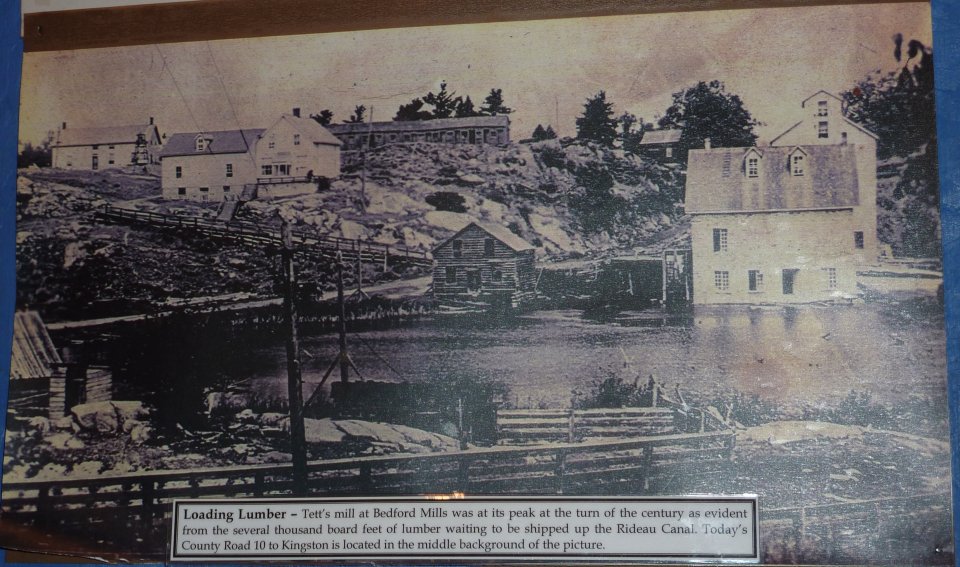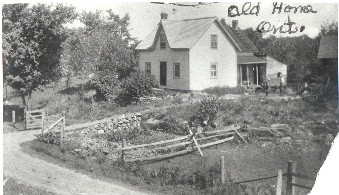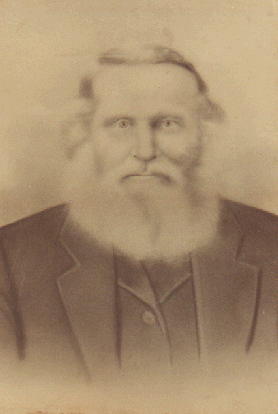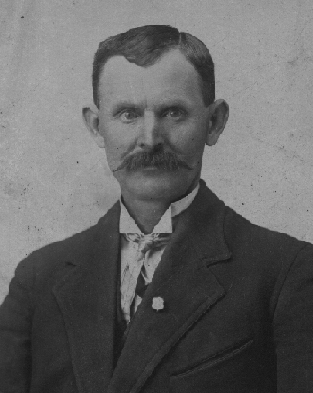
Bedford Mills before 1900. Of all the buildings in this photo, only the grist mill (on the right at the water's edge) still stands. (Westport Museum)
Jane was the 20 year old daughter and likely eldest child of North Crosby residents John and Elizabeth Whitmarsh. John was probably born in New York state between 1786 and 1789, but by Jane's birth about 1825 he was married to Scotland-born Elizabeth and living in what is now Ontario. According to assessment rolls, the Whitmarshes settled in North Crosby in 1843.
William's origins, on the other hand, are nearly a complete mystery. At the time of his marriage to Jane he was about 21 years old, and by most accounts he was born somewhere in Ontario. A few shadows of his early life have been found. In his later years it was published that he was a veteran of the loyalist (government) side in the Upper Canada rebellion of 1837-38, when he must have been not more than 14 or 15 years old. In 1891 censustakers asked people where their parents were born and for William the answer was “Ontario” for both. He and Jane are not identifiable in North Crosby census or assessment rolls until 1847, suggesting they lived elsewhere for the first couple of years of their married life.
At other times William worked in the sawmill, farmed, and did carpentry. A list of Tett employees from 1853 lists a “W. Wyatt” as a mill worker, and an “E. Wyatt” as a “shanty”. It isn't known who “E. Wyatt” was, and no such person appears in the census in 1851-52 or in 1861. Perhaps William had a brother. In later years William's occupation was almost always described as a farmer or a carpenter, and it's almost certain he did both simultaneously. The family farm, such as it was, most often amounted to less than 50 acres, not all of it cultivated. On at least one occasion William was described as a “joiner,” a carpenter who crafted wood into furniture or other finished products.
Jane too made a contribution to the family income. She bought industrious quantities of cloth and thread from the Tett's general store at Newboro. While there is no record of exactly what she did with all that cloth, it seems a logical conclusion that at least a few of the district's men and women must have worn Wyatt brand shirts or dresses.
The Tett merchant records paint an interesting picture of what a young family in the wilds of eastern Ontario had to buy in the 1840s. It was typical of the time for most families to be largely self-sufficient, raising livestock and growing food to feed themselves, but there were always a few products which could only be bought. Most frequently they bought tea, tobacco, saleratus (a leavening agent for baking), and several kinds of cloth (including silk on one occasion) but other, less frequent purchases included a wide range of goods: chalklines, gloves, spools, buttons, nails, thimbles, cups and saucers, plates, raisins, pepper, shoes, sugar, marrow fat peas, soap, pipes, beans, flour, rope, paper pins, a pail, scissors, wood combs, tacks, and tar. A black teapot was bought for a shilling and six pence (30 cents) on March 17th, 1848.
The general stores at Newboro and Bedford Mills were owned by the sawmill Tetts and credit accounts functioned like the community bank. Earnings at the sawmill could be credited against the account, purchases debited against it, and even payments to third parties made through it. On March 9th, 1848, William's running tab at Tett's general store was used to pay Dr. Bresee fifteen shillings ($3.00).
During the time of William and Jane's marriage, the Wyatts lived beside the Whitmarshes on lot six in the tenth concession of North Crosby Township, a couple of miles north of the tiny community of Bedford Mills. When William was born about 1824 neither Newboro nor Bedford Mills existed, and the population of all of North Crosby Township was but a few dozen. This makes it quite unlikely William was born there.
Settlement came to North Crosby in 1826 when construction began on the Rideau Canal between Kingston and Ottawa. Newboro marks the highest point of land on the waterway, and the location of the locks and canal connecting the Ottawa River and Lake Ontario watersheds. Newboro was the township's principal town for many years, until eclipsed by Westport at the end of the 19th Century.

Bedford Mills began about 1830 when Benjamin Tett, drawn to North Crosby by the construction of the Rideau Canal at Newboro, saw opportunity in the region's seemingly unlimited forests, the waterpower of Buttermilk Falls, and the access to markets afforded by the new canal. He and his partners the Chaffey brothers built a sawmill at the base of the falls on the shore of Newboro (Loon) Lake. This location was in Bedford Township, Frontenac County, a few hundred yards west of the North Crosby boundary, and acquired the name Bedford Mills when a post office was built in 1835. The community that grew up around the sawmill, grist mill, boarding house, and general store (all Tett businesses) was never very large. At its peak perhaps a couple dozen people lived in the village itself, with others like the Wyatts settled nearby in the rocky, wooded countryside. The community went into decline shortly after 1900 and today only the grist mill, now a private home, and St. Stephen's Anglican church, built in 1907, remain in town. The surrounding district is popular cottage country, and the woods and lake shores are dotted with weekend homes. It's quite likely that on a summer Saturday night more people “live” at Bedford Mills today than ever did when it was a thriving village.
William and Jane produced a family of three daughters, Mary Elizabeth (sometimes “May” sometimes “Libby”) was born about 1846, Sarah Demira “Dee” in 1848, and Adeline about 1851, before Jane's untimely death sometime between 1852 and 1854. The 1848 census also records a death in the family in the preceeding twelve months, perhaps the loss of a fourth child. No direct record of Jane's death has yet been discovered, but William's daughter Clarinda, born in 1856, was the daughter of his second wife Ann.
Ann Taylor was born in Ireland and probably immigrated to Canada as a child. Her age is hard to pin down exactly, but the evidence suggests she was born about 1837, making her twelve or thirteen years William's junior and about 18 when they were married. (He was about 31). As Ann grew older, her birthdate seemed to retreat. The 1901 census says she was born in 1832, and by the time of her death in 1905 she was reportedly born about 1820. Whatever her actual birth date, she was from County Sligo, Ireland, and her parents were Samuel Taylor and Mary Crawford. Her sister Jane Taylor lived for a time in the 1870's with William and Ann.
Ann assumed the role of step-mother to William's three daughters, and gave him eight more children, four daughters and four sons. Clarinda was born in 1856, Alexander Russell in 1858, Eliza Jane in 1860, George Samuel in 1865, James Robert in 1867, Lily Isabel in 1870, William Isaac in 1872, and Laura Augusta in 1874.
Marrying Ann converted William from Methodist to Anglican. This would stick until the last few years of his life when William converted again, this time to the Presbyterian church. Regardless of his denomination, William was a loyal Orangeman. When the Loyal Orange Lodge opened at Newboro in 1856, William became an early and life-long member. Several of the Whitmarshes also appear among the lodge's membership rolls. In later years his son James and son-in-law James Moulton also belonged. For a time William served on the disciplinary committee and although he could not read or write, letters bearing his “X” still exist among the lodge papers.
By 1861 William and his new wife had moved a short distance away from the Whitmarshes, to fifty acres on lot eight in the ninth concession, but the families must have remained close, through their Orange Lodge connections, and in the relationships between the three older girls and their Whitmarsh relatives. In 1861 twelve-year-old Sarah Wyatt was living with the Whitmarshes, perhaps helping to keep house for her uncle John and aunt Rachael.
The entire Wyatt family never lived under the same roof at the same time. The first two children to move out of the home, Mary Elizabeth and Sarah Demira were both married in 1867, before the last three children were born. Twenty-eight years separated the eldest from the youngest, and the eldest children of eldest two daughters were older than some of their aunts and uncles.
 |
The Tett family operated a boarding house and restaurant at Bedford Mills and their lunch records for a few months in 1887 and 1889 have been preserved. Willie and Jim Wyatt are among the diners names, indicating they probably earned credit working for the Tett enterprises which they spent at lunch.

| date unknown |
William Wyatt died on Monday, January 28th, 1895. His will, written the day he died, left all of his estate (except one dollar) to his unmarried son William, Jr., on the condition that he look after his widowed mother Ann. Why the other unmarried child, twenty-nine year old son George, was left one dollar and the married children were not mentioned, is not known. The will was witnessed by John C. Roushorn, William's son-in-law.
The Orange Lodge met two days later, on Wednesday January 30th, and in a rare departure from form the minutes include an obituary of sorts.
the Desest William Wiants remains has been plasd in the voalt by the Brothern of this Lodge.William was buried in what is now the United Church Cemetery in Westport. His widow Ann accompanied her son William, Jr., to Manitoba, and died at West Hall in 1905, a decade after her husband. Burial record for William's first wife Jane has not been found.
There also appears to be no pattern of change, gradual or otherwise, to the spellings. Weagant, which looks like an older, antique and perhaps more German spelling, ranges only from 1880 to 1910. Wyant is the name used in the earliest known record, in 1845, and as late as 1901. Wyatt, the spelling used today, appears as early as 1852. Waggett comes from an 1849 list, and Wageant from baptisms in 1868 and 1871. Several months apart in 1867 two of William's daughters were married, by the same minister. One was recorded as Sarah Wyat, the other as Eliz. Wygent.
In 1901 Clarinda was specifically recorded as German among her Irish husband and children, and in 1871 the whole family was listed as “Dutch”. “Dutch” again appears in the 1901 Census, carefully noted as the ethnicity of Eliza Jane while her husband and daughters are English. The word “Dutch” comes from “Deutsch”, meaning German. There are also the variants of the family surname that make Irish ancestry less likely. “Weagant” and versions like it are very similar to the German surname Weygandt. Even “Wyatt” is not typically an Irish name.
The divide by age group is strong testament to when and where the people of eastern Ontario saw better opportunity. In the 1860s through 1880s it was to Michigan. Beginning in the 1890s it was western Canada. For those who came of age in between, staying closer to home seemed the best choice.
Sarah, also known as “Dee”, and George remained in eastern Ontario until about 1879 when they relocated to Detroit, Michigan. Children Thomas George (b. 1868), John L. “Jack” (b. c1872), Charles, Edith (b. c1874), and William James (b. c1877), were born in Canada. A son Albert Ezra was born in Detroit in 1890. Jack and Thomas Simmons, like their father George, became sailors on the Great Lakes. Demira died at Detroit in 1914.
James Moulton (c1853-1934) rose to some prominence in the small and dwindling community of Bedford Mills. In 1891 he was head (“Worshipful Master”) of the Orange Lodge. For several years he was manager of the Tett's sawmill. William Jr. sold him the Wyatt family farm in 1901. In 1932 the Westport newspaper described him as one of the last old-timers left at Bedford Mills.
Of Clarinda and James' eight surviving children, six, William (1876-1925), Edmond (1885-1968), Pearl (1890-1958), Harford (1893-1968), Margret (1894-1947), and Myrtle (1902-1991), remained all their lives in eastern Ontario. Only Alexander (1878-1949), who settled at Sudbury, and Frederick (1888-1977), who lived much of his life in the United States, left the region altogether. Frederick and Edmond enlisted in the Canadian Over-Seas Expeditionary Force to fight in World War I. Frederick's experience could not have been a happy one, and his desertion likely prompted his life in exile in the United States. He returned to North Crosby only in retirement, and is buried in a Westport cemetery.
George Wyatt appears often in reports from Bedford Mills published in Kingston newspapers. Between 1890 and 1895 he is mentioned at least 15 times. Besides falling ill with influenza (March 1893), getting lost in the woods (November 1893), and working as a travelling salesman for fruit and shade trees (November and December 1894), his most frequent mentions were about winning local foot races. By April 1895 one correspondent called him “our famous runner”. In one particularly cocky boast in August 1893 George offered to bet $50 he could beat any challenger from Leeds County.
Tracing George after 1901 has been difficult. There is a George Wyatt of appropriate age, religion, birth province, and ethnicity, still a bachelor at age 51, working as a grocer at Jasper National Park, Alberta, in 1916. A possible match in the 1921 census is a resident and handyman, still single at 56, at Brockville Hospital. If either of these are our George then his story might yet emerge.

|
circa 1910 |
James returned to North Crosby around 1889. He moved back into the family home and joined the Orange Lodge where his father was already a member. March 25th, 1891 in nearby Battersea he married Jessie Clark, daughter of farmers William Clark and Nancy Abernethy. The wedding was a double ceremony. James' sister Laura married Jessie's brother Robert at the same time. The marriages were performed by Rev. William Ebersole of the Messiah denomination. The Clarks were generally Methodists, and the Wyatts, since Ann Taylor married William senior, had been Anglicans. Who or what the Messiah church was is unknown. Ebersole, himself the son of another Messiah preacher, appears as a Baptist in the 1901 census.
James and Jessie remained in North Crosby, beginning their family with a daughter Adeline Mary (named perhaps after two of James' older sisters) born in March of 1892. Adeline is believed to have died at about two years old. Two sons followed, Ross in 1895 and William in 1897, before James and Jessie left North Crosby to settle near Deleau in western Manitoba. Two more children were born in Manitoba, Lillian in 1899 and Winnifred in 1902. By 1901 the Wyatts were sharing their Manitoba farm with Jessie's sister Ellen and her husband Manfred McGuffin. James' brother William, and their mother Ann also arrived from North Crosby in 1901. The western Canada branch of the Wyatts of North Crosby was firmly established.
James and Jessie moved on to Saskatchewan about 1903 when they homesteaded a quarter section just outside Elstow. One more son, Bryce, was born there in 1907. In late 1909 Jessie fell ill. It was only a few months after her brother Robert had died, and not quite two years after James' sister Laura's death. Jessie was sent to hospital in Brandon, Manitoba. On Monday, February 21st, 1910, after three months illness, Jessie died of pyemia. Three of the four people married in the double wedding at Battersea in 1891 were dead. Jessie was returned to Elstow for burial.
James, with a household of children, remarried. His second wife was Kate Green, an eighteen-year-old Irish immigrant. James and Kate had two daughters, Helen Gertrude (called Nellie) in 1912 and Ann Elizabeth in 1913. About this time James moved his family to the Louvain school district just north of Biggar, Saskatchewan. Kate died on July 4th, 1914, and is buried next to Jessie in Elstow cemetery. Unable to look after two infant girls, Nellie and Ann were fostered by families in the area. For Nellie this would be permanent. Her new Scott family changed her name to Jean, and a few years later moved back to Oshawa, Ontario.

|
Jim and Alice remained in the Louvain/Gagenville area, just north of Biggar, for the rest
of their marriage. Alice was a midwife at the birth of countless local children.
Jim developed a reputation as an outstanding fiddler and step-dancer. Alice was
secretary (and organist, when required) for Gagenville School for many years, and Jim helped local farmers
with their veterinary needs. Alice died in 1941 and is buried at Biggar. Jim,
elderly and nearly blind, went to live with his son Bryce at Perdue. He died in 1949 and is buried at Perdue.
Jennie was fostered by her uncle and aunt James and Jessie Wyatt, then by another uncle and aunt, William and Bertha Wyatt. It is interesting to note that she named daughters after both of her foster mothers, but not after Lilly. Jennie is not mentioned in her mother's nor in any of her half-siblings' obituaries.
John and Lilly Roushorn remained at Fort William. John died in 1929 and Lilly in 1934.
John and Lilly's children married and spread out across the continent. Inez married Charles Stewart Parnell “Patty” Whalen and was living in Ottawa when she died in 1958. Blanche married George Lewis Wannan in 1922, but by 1950 was married to Clifford Cushing and living in Wyandotte, Michigan, where she died in 1960. Clara's first husband was Robert James Armstrong and they lived in Grand Forks, BC. Her second husband was Emil Per Bystrom and she was living in Nanaimo BC when she died in 1988. Bessie married William Marchbank in 1924 but by 1950 her husband was W. Saunders. Howard, by then living at Baie-Comeau, Quebec, was one of four men who disappeared when a sudden storm overcame their fishing trip on the St. Lawrence River at Godbout in 1952. Beatrice settled with husband Matthew James Williams in Corner Brook, Nfld., but eventually resettled without her first family in British Columbia. She married a second time, to Oskar Alvin Persson.
Billy and Bert lived out their lives in Hartney, Manitoba, until Bert's death in 1964 at the age of 81. Billy then moved into Winnipeg to live with Dora and her family until his death in 1969 at the age of 96, the last of his generation. He is buried next to Bertha in Riverside Cemetery at Hartney.
The fate of the Clark orphans must have been a difficult one for the extended family. The children were separated. Seventeen year-old Ernie went to live with his uncle William Clark at Waskatenau, Alberta. Three year-old Addie stayed at Saskatoon with her father's first cousin, George E. Clark. The three other girls, Dora, nine, Grace, seven, and Belle, five, were sent to live with their uncle William “Billy” Wyatt in Manitoba.